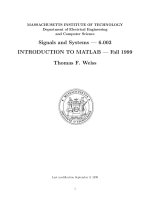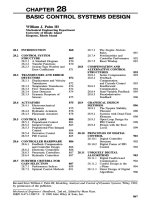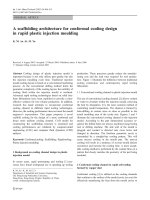matlab simulations for radar systems design - bassem r. mahafza & atef z. elsherbeni
Bạn đang xem bản rút gọn của tài liệu. Xem và tải ngay bản đầy đủ của tài liệu tại đây (33.52 MB, 686 trang )
CHAPMAN & HALL/CRC
A CRC Press Company
Boca Raton London New York Washington, D.C.
Simulations for
Radar Systems
Design
Bassem R. Mahafza, Ph.D.
Decibel Research, Inc.
Huntsville, Alabama
Atef Z. Elsherbeni
Professor
Electrical Engineering Department
The University of Mississippi
Oxford, Mississippi
© 2004 by Chapman & Hall/CRC CRC Press LLC
This book contains information obtained from authentic and highly regarded sources. Reprinted material
is quoted with permission, and sources are indicated. A wide variety of references are listed. Reasonable
efforts have been made to publish reliable data and information, but the author and the publisher cannot
assume responsibility for the validity of all materials or for the consequences of their use.
Neither this book nor any part may be reproduced or transmitted in any form or by any means, electronic
or mechanical, including photocopying, microfilming, and recording, or by any information storage or
retrieval system, without prior permission in writing from the publisher.
The consent of CRC Press LLC does not extend to copying for general distribution, for promotion, for
creating new works, or for resale. Specific permission must be obtained in writing from CRC Press LLC
for such copying.
Direct all inquiries to CRC Press LLC, 2000 N.W. Corporate Blvd., Boca Raton, Florida 33431.
Trademark Notice:
Product or corporate names may be trademarks or registered trademarks, and are
used only for identification and explanation, without intent to infringe.
Visit the CRC Press Web site at www.crcpress.com
© 2004 by Chapman & Hall/CRC CRC Press LLC
No claim to original U.S. Government works
International Standard Book Number 1-58488-392-8
Library of Congress Catalog Number 2003065397
Printed in the United States of America 1 2 3 4 5 6 7 8 9 0
Printed on acid-free paper
Library of Congress Cataloging-in-Publication Data
Mahafza, Bassem R.
MATLAB simulations for radar systems design / Bassem R. Mahafza, Atef
Z. Elsherbeni
p. cm.
Includes bibliographical references and index.
ISBN 1-58488-392-8 (alk. paper)
1. Radar–Computer simulation. 2. Radar–Equipment and
supplies–Design and construction–Data processing. 3. MATLAB. I.
Elsherbeni, Atef Z. II. Title
TK6585.M34 2003
621.3848
′
01
′
13—dc22 2003065397
C3928_disclaimer Page 1 Wednesday, November 5, 2003 1:36 PM
© 2004 by Chapman & Hall/CRC CRC Press LLC
To: My wife and four sons;
Wayne and Shirley;
and
in the memory of my parents
Bassem R. Mahafza
To: My wife and children;
my mother;
and
in the memory of my father
Atef Z. Elsherbeni
© 2004 by Chapman & Hall/CRC CRC Press LLC
Preface
The emphasis of “MATLAB Simulations for Radar Systems Design” is on
radar systems design. However, a strong presentation of the theory is provided
so that the reader will be equipped with the necessary background to perform
radar systems analysis. The organization of this book is intended to teach a
conceptual design process of radars and related trade-off analysis and calcula
-
tions. It is intended to serve as an engineering reference for radar engineers
working in the field of radar systems. The MATLAB
®1
code provided in this
book is designed to provide the user with hands-on experience in radar sys-
tems, analysis and design.
A radar design case study is introduced in Chapter 1 and carried throughout
the text, where the authors’ view of how to design this radar is detailed and
analyzed. Trade off analyses and calculations are performed. Additionally, sev
-
eral mini design case studies are scattered throughout the book.
“MATLAB Simulations for Radar Systems Design” is divided into two parts:
Part I provides a comprehensive description of radar systems, analyses and
design. A design case study, which is carried throughout the text, is introduced
in Chapter 1. In each chapter the authors’ view of how to design the case-study
radar is presented based on the theory covered up to that point in the book. As
the material coverage progresses through the book, and new theory is dis
-
cussed, the design case-study requirements are changed and/or updated, and of
course the design level of complexity is also increased. This design process is
supported by a comprehensive set of MATLAB 6 simulations developed for
this purpose. This part will serve as a valuable tool to students and radar engi
-
neers in helping them understand radar systems, design process. This includes
1) learning how to go about selecting different radar parameters to meet the
design requirements; 2) performing detailed trade-off analysis in the context of
radar sizing, modes of operations, frequency selection, waveforms and signal
processing; 3) establishing and developing loss and error budgets associated
with the design; and 4) generating an in-depth understanding of radar opera
-
tions and design philosophy. Additionally, Part I includes several mini design
case studies pertinent to different chapters in order to help enhance understand
-
ing of radar design in the context of the material presented in different chap-
ters.
Part II includes few chapters that cover specialized radar topics, some of
which is authored and/or coauthored by other experts in the field. The material
1. MATLAB is a registered trademark of the The MathWorks, Inc. For product infor-
mation, please contact: The MathWorks, Inc., 3 Apple Hill Drive, Natick, MA
01760-2098 USA. Web: www.mathworks.com.
© 2004 by Chapman & Hall/CRC CRC Press LLC
included in Part II is intended to further enhance the understanding of radar
system analysis by providing detailed and comprehensive coverage of these
radar related topics. For this purpose, MATLAB 6 code has also been devel
-
oped and made available.
All MATLAB programs and functions provided in this book can be down-
loaded from the CRC Press Web site (www.crcpress.com). For this purpose,
follow this procedure: 1) from your Web browser type “
-
press.com”, 2) click on “Electronic Products”, 3) click on “Download &
Updates”, and finally 4) follow instructions of how to download a certain set
of code off that Web page. Furthermore, this MATLAB code can also be down
-
loaded from The MathWorks Web site by following these steps: 1) from your
Web browser type: “ 2)
place the curser on “Companion Software for Books” and click on “Communi
-
cations”. The MATLAB functions and programs developed in this book
include all forms of the radar equation: pulse compression, stretch processing,
matched filter, probability of detection calculations with all Swerling models,
High Range Resolution (HRR), stepped frequency waveform analysis, ghk
tracking filter, Kalman filter, phased array antennas, clutter calculations, radar
ambiguity functions, ECM, chaff, and many more.
Chapter 1 describes the most common terms used in radar systems, such as
range, range resolution, and Doppler frequency. This chapter develops the
radar range equation. Finally, a radar design case study entitled “MyRadar
Design Case Study” is introduced. Chapter 2 is intended to provide an over
-
view of the radar probability of detection calculations and related topics.
Detection of fluctuating targets including Swerling I, II, III, and IV models is
presented and analyzed. Coherent and non-coherent integration are also intro
-
duced. Cumulative probability of detection analysis is in this chapter. Visit 2 of
the design case study “MyRadar” is introduced.
Chapter 3 reviews radar waveforms, including CW, pulsed, and LFM. High
Range Resolution (HRR) waveforms and stepped frequency waveforms are
also analyzed. The concept of the Matched Filter (MF) is introduced and ana
-
lyzed. Chapter 4 presents in detail the principles associated with the radar
ambiguity function. This includes the ambiguity function for single pulse, Lin
-
ear Frequency Modulated pulses, train of unmodulated pulses, Barker codes,
and PRN codes. Pulse compression is introduced in Chapter 5. Both the MF
and the stretch processors are analyzed.
Chapter 6 contains treatment of the concepts of clutter. This includes both
surface and volume clutter. Chapter 7 presents clutter mitigation using Moving
Target Indicator (MTI). Delay line cancelers implementation to mitigate the
effects of clutter is analyzed.
Chapter 8 presents detailed analysis of Phased Arrays. Linear arrays are
investigated and detailed and MATLAB code is developed to calculate and plot
© 2004 by Chapman & Hall/CRC CRC Press LLC
the associated array patterns. Planar arrays, with various grid configurations,
are also presented.
Chapter 9 discusses target tracking radar systems. The first part of this chap-
ter covers the subject of single target tracking. Topics such as sequential lob-
ing, conical scan, monopulse, and range tracking are discussed in detail. The
second part of this chapter introduces multiple target tracking techniques.
Fixed gain tracking filters such as the
and the filters are presented in
detail. The concept of the Kalman filter is introduced. Special cases of the Kal-
man filter are analyzed in depth.
Chapter 10 is coauthored with Mr. J. Michael Madewell from the US Army
Space and Missile Defense Command, in Huntsville, Alabama. This chapter
presents an overview of Electronic Counter Measures (ECM) techniques. Top
-
ics such as self screening and stand off jammers are presented. Radar chaff is
also analyzed and a chaff mitigation technique for Ballistic Missile Defense
(BMD) is introduced.
Chapter 11 is concerned with the Radar Cross Section (RCS). RCS depen-
dency on aspect angle, frequency, and polarization is discussed. The target
scattering matrix is developed. RCS formulas for many simple objects are pre
-
sented. Complex object RCS is discussed, and target fluctuation models are
introduced. Chapter 12 is coauthored with Dr. Brian Smith from the US Army
Aviation and Missile Command (AMCOM), Redstone Arsenal in Alabama.
This chapter presents the topic of Tactical Synthetic Aperture Radar (SAR).
The topics of this chapter include: SAR signal processing, SAR design consid
-
erations, and the SAR radar equation. Finally Chapter 13 presents an overview
of signal processing.
Using the material presented in this book and the MATLAB code designed
by the authors by any entity or person is strictly at will. The authors and the
publisher are neither liable nor responsible for any material or non-material
losses, loss of wages, personal or property damages of any kind, or for any
other type of damages of any and all types that may be incurred by using this
book.
Bassem R. Mahafza
Huntsville, Alabama
July, 2003
Atef Z. Elsherbeni
Oxford, Mississippi
July, 2003
αβ αβγ
© 2004 by Chapman & Hall/CRC CRC Press LLC
Acknowledgment
The authors first would like to thank God for giving us the endurance and
perseverance to complete this work. Many thanks are due to our families who
have given up and sacrificed many hours in order to allow us to complete this
book. The authors would like to also thank all of our colleagues and friends for
their support during the preparation of this book. Special thanks are due to
Brian Smith, James Michael Madewell, Patrick Barker, David Hall, Mohamed
Al-Sharkawy, and Matthew Inman who have coauthored and/or reviewed some
of the material in this reference book.
© 2004 by Chapman & Hall/CRC CRC Press LLC
Table of Contents
Preface
Acknowledgment
PART I
Chapter 1
Introduction to Radar Basics
1.1. Radar Classifications
1.2. Range
1.3. Range Resolution
1.4. Doppler Frequency
1.5. The Radar Equation
1.5.1. Radar Reference Range
1.6. Search (Surveillance)
1.6.1. Mini Design Case Study 1.1
1.7. Pulse Integration
1.7.1. Coherent Integration
1.7.2. Non-Coherent Integration
1.7.3. Detection Range with Pulse Integration
1.7.4. Mini Design Case Study 1.2
1.8. Radar Losses
1.8.1. Transmit and Receive Losses
1.8.2. Antenna Pattern Loss and Scan Loss
1.8.3. Atmospheric Loss
1.8.4. Collapsing Loss
1.8.5. Processing Losses
1.8.6. Other Losses
1.9. “MyRadar” Design Case Study - Visit 1
© 2004 by Chapman & Hall/CRC CRC Press LLC
1.9.1 Authors and Publisher Disclaimer
1.9.2. Problem Statement
1.9.3. A Design
1.9.4. A Design Alternative
1.10. MATLAB Program and Function Listings
Listing 1.1. Function “radar_eq.m”
Listing 1.2. Program “fig1_12.m”
Listing 1.3. Program “fig1_13.m”
Listing 1.4. Program “ref_snr.m”
Listing 1.5. Function “power_aperture.m”
Listing 1.6. Program “fig1_16.m”
Listing 1.7. Program “casestudy1_1.m”
Listing 1.8. Program “fig1_19.m”
Listing 1.9. Program “fig1_21.m”
Listing 1.10. Function “pulse_integration.m”
Listing 1.11. Program “myradarvisit1_1.m”
Listing 1.12. Program “fig1_27.m”
Appendix 1A
Pulsed Radar
1A.1. Introduction
1A.2. Range and Doppler Ambiguities
1A.3. Resolving Range Ambiguity
1A.4. Resolving Doppler Ambiguity
Appendix 1B
Noise Figure
Chapter 2
Radar Detection
2.1. Detection in the Presence of Noise
2.2. Probability of False Alarm
2.3. Probability of Detection
2.4. Pulse Integration
2.4.1. Coherent Integration
2.4.2. Non-Coherent Integration
2.4.3. Mini Design Case Study 2.1
2.5. Detection of Fluctuating Targets
2.5.1. Threshold Selection
© 2004 by Chapman & Hall/CRC CRC Press LLC
2.6. Probability of Detection Calculation
2.6.1. Detection of Swerling V Targets
2.6.2. Detection of Swerling I Targets
2.6.3. Detection of Swerling II Targets
2.6.4. Detection of Swerling III Targets
2.6.5. Detection of Swerling IV Targets
2.7. The Radar Equation Revisited
2.8. Cumulative Probability of Detection
2.8.1. Mini Design Case Study 2.2
2.9. Constant False Alarm Rate (CFAR)
2.9.1. Cell-Averaging CFAR (Single Pulse)
2.9.2. Cell-Averaging CFAR with Non-Coherent Integra-
tion
2.10. “MyRadar” Design Case Study - Visit 2
2.10.1. Problem Statement
2.10.2. A Design
2.10.2.1. Single Pulse (per Frame) Design Option
2.10.2.2. Non-Coherent Integration Design Option
2.11. MATLAB Program and Function Listings
Listing 2.1. Program “fig2_2.m”
Listing 2.2. Function “que_func.m”
Listing 2.3. Program “fig2_3.m”
Listing 2.4. Function “marcumsq.m”
Listing 2.5. Program “prob_snr1.m”
Listing 2.6. Program “fig2_6a.m”
Listing 2.7. Function “improv_fac.m”
Listing 2.8 Program “fig2_6b.m”
Listing 2.9. Function “incomplete_gamma.m”
Listing 2.10. Function “factor.m”
Listing 2.11. Program “fig2_7.m”
Listing 2.12. Function “threshold.m”
Listing 2.13. Program “fig2_8.m”
Listing 2.14. Function “pd_swerling5.m”
Listing 2.15. Program “fig2_9.m”
Listing 2.16. Function “pd_swerling1.m”
Listing 2.17. Program “fig2_10.m”
Listing 2.18. Program “fig2_11ab.m”
Listing 2.19. Function “pd_swerling2.m”
Listing 2.20. Program “fig2_12.m”
Listing 2.21. Function “pd_swerling3.m”
Listing 2.22. Program “fig2_13.m”
Listing 2.23 Function “pd_swerling4.m”
Listing 2.24. Program “fig2_14.m”
© 2004 by Chapman & Hall/CRC CRC Press LLC
Listing 2.25. Function “fluct_loss.m”
Listing 2.26. Program “fig2_16.m”
Listing 2.27. Program “myradar_visit2_1.m”
Listing 2.28. Program “myradar_visit2_2.m”
Listing 2.29. Program “fig2_21.m”
Chapter 3
Radar Waveforms
3.1. Low Pass, Band Pass Signals and Quadrature
Components
3.2. The Analytic Signal
3.3. CW and Pulsed Waveforms
3.4. Linear Frequency Modulation Waveforms
3.5. High Range Resolution
3.6. Stepped Frequency Waveforms
3.6.1. Range Resolution and Range Ambiguity
in SWF
3.6.2. Effect of Target Velocity
3.7. The Matched Filter
3.8. The Replica
3.9. Matched Filter Response to LFM Waveforms
3.10. Waveform Resolution and Ambiguity
3.10.1. Range Resolution
3.10.2. Doppler Resolution
3.10.3. Combined Range and Doppler Resolution
3.11. “Myradar” Design Case Study - Visit 3
3.11.1. Problem Statement
3.11.2. A Design
3.12. MATLAB Program and Function Listings
Listing 3.1. Program “fig3_7.m”
Listing 3.2. Program “fig3_8.m”
Listing 3.3. Function “hrr_profile.m”
Listing 3.4. Program “fig3_17.m”
Chapter 4
The Radar Ambiguity Function
4.1. Introduction
4.2. Examples of the Ambiguity Function
4.2.1. Single Pulse Ambiguity Function
4.2.2. LFM Ambiguity Function
© 2004 by Chapman & Hall/CRC CRC Press LLC
4.2.3. Coherent Pulse Train Ambiguity Function
4.3. Ambiguity Diagram Contours
4.4. Digital Coded Waveforms
4.4.1. Frequency Coding (Costas Codes)
4.4.2. Binary Phase Codes
4.4.3. Pseudo-Random (PRN) Codes
4.5. “MyRadar” Design Case Study - Visit 4
4.5.1. Problem Statement
4.5.2. A Design
4.6. MATLAB Program and Function Listings
Listing 4.1. Function “single_pulse_ambg.m”
Listing 4.2. Program “fig4_2.m”
Listing 4.3. Program “fig4_4.m”
Listing 4.4. Function “lfm_ambg.m”
Listing 4.5. Program “fig4_5.m”
Listing 4.6. Program “fig4_6.m”
Listing 4.7. Function “train_ambg.m”
Listing 4.8. Program “fig4_8.m”
Listing 4.9. Function “barker_ambg.m”
Listing 4.10. Function “prn_ambg.m”
Listing 4.11. Program “myradar_visit4.m”
Chapter 5
Pulse Compression
5.1. Time-Bandwidth Product
5.2. Radar Equation with Pulse Compression
5.3. LFM Pulse Compression
5.3.1. Correlation Processor
5.3.2. Stretch Processor
5.3.3. Distortion Due to Target Velocity
5.4. “MyRadar” Design Case Study - Visit 5
5.4.1. Problem Statement
5.4.2. A Design
5.5. MATLAB Program and Function Listings
Listing 5.1. Program “fig5_3.m”
Listing 5.2. Function “matched_filter.m”
Listing 5.3. Function “power_integer_2.m”
Listing 5.4. Function “stretch.m”
Listing 5.5. Program “fig5_14.m”
© 2004 by Chapman & Hall/CRC CRC Press LLC
Chapter 6
Surface and Volume Clutter
6.1. Clutter Definition
6.2. Surface Clutter
6.2.1. Radar Equation for Area Clutter - Airborne Radar
6.6.2. Radar Equation for Area Clutter - Ground Based
Radar
6.3. Volume Clutter
6.3.1. Radar Equation for Volume Clutter
6.4. Clutter Statistical Models
6.5. “MyRadar” Design Case Study - Visit 6
6.5.1. Problem Statement
6.5.2. A Design
6.6. MATLAB Program and Function Listings
Listing 6.1. Function “clutter_rcs.m”
Listing 6.2. Program “myradar_visit6.m”
Chapter 7
Moving Target Indicator (MTI) and Clutter Mitiga-
tion
7.1. Clutter Spectrum
7.2. Moving Target Indicator (MTI)
7.3. Single Delay Line Canceler
7.4. Double Delay Line Canceler
7.5. Delay Lines with Feedback (Recursive Filters)
7.6. PRF Staggering
7.7. MTI Improvement Factor
7.7.1. Two-Pulse MTI Case
7.7.2. The General Case
7.8. “MyRadar” Design Case Study - Visit 7
7.8.1. Problem Statement
7.8.2. A Design
7.9. MATLAB Program and Function Listings
Listing 7.1. Function “single_canceler.m”
Listing 7.2. Function “double_canceler.m”
Listing 7.3. Program “fig7_9.m”
Listing 7.4. Program “fig7_10.m”
Listing 7.5. Program “fig7_11.m”
Listing 7.4. Program “myradar_visit7.m”
© 2004 by Chapman & Hall/CRC CRC Press LLC
Chapter 8
Phased Arrays
8.1. Directivity, Power Gain, and Effective Aperture
8.2. Near and Far Fields
8.3. General Arrays
8.4. Linear Arrays
8.4.1. Array Tapering
8.4.2. Computation of the Radiation Pattern via the DFT
8.5. Planar Arrays
8.6. Array Scan Loss
8.7. “MyRadar” Design Case Study - Visit 8
8.7.1. Problem Statement
8.7.2. A Design
8.8. MATLAB Program and Function Listings
Listing 8.1. Program “fig8_5.m”
Listing 8.2. Program “fig8_7.m”
Listing 8.3. Function “linear_array.m”
Listing 8.4. Program “circular_array.m”
Listing 8.5. Function “rect_array.m”
Listing 8.6. Function “circ_array.m”
Listing 8.7. Function “rec_to_circ.m”
Listing 8.8. Program “fig8_53.m”
Chapter 9
Target Tracking
Single Target Tracking
9.1. Angle Tracking
9.1.1. Sequential Lobing
9.1.2. Conical Scan
9.2. Amplitude Comparison Monopulse
9.3. Phase Comparison Monopulse
9.4. Range Tracking
Multiple Target Tracking
9.5. Track-While-Scan (TWS)
9.6. State Variable Representation of an LTI System
9.7. The LTI System of Interest
9.8. Fixed-Gain Tracking Filters
9.8.1. The Filter
9.8.2. The Filter
αβ
αβγ
© 2004 by Chapman & Hall/CRC CRC Press LLC
9.9. The Kalman Filter
9.9.1. The Singer -Kalman Filter
9.9.2. Relationship between Kalman and
Filters
9.10. “MyRadar” Design Case Study - Visit 9
9.10.1. Problem Statement
9.10.2. A Design
9.11. MATLAB Program and Function Listings
Listing 9.1. Function “mono_pulse.m”
Listing 9.2. Function “ghk_tracker.m”
Listing 9.3. Program “fig9_21.m”
Listing 9.4. Function “kalman_filter.m”
Listing 9.5. Program “fig9_28.m”
Listing 9.6. Function “maketraj.m”
Listing 9.7. Function “addnoise.m”
Listing 9.8. Function “kalfilt.m”
PART II
Chapter 10
Electronic Countermeasures (ECM)
10.1. Introduction
10.2. Jammers
10.2.1. Self-Screening Jammers (SSJ)
10.2.2. Stand-Off Jammers (SOJ)
10.3. Range Reduction Factor
10.4. Chaff
10.4.1. Multiple MTI Chaff Mitigation Technique
10.5. MATLAB Program and Function Listings
Listing 10.1. Function “ssj_req.m”
Listing 10.2. Function “sir.m”
Listing 10.3. Function “burn_thru.m”
Listing 10.4. Function “soj_req.m”
Listing 10.5. Function “range_red_factor.m”
Listing 10.6. Program “fig8_10.m”
Chapter 11
Radar Cross Section (RCS)
11.1. RCS Definition
11.2. RCS Prediction Methods
11.3. Dependency on Aspect Angle and Frequency
αβγ
αβγ
© 2004 by Chapman & Hall/CRC CRC Press LLC
11.4. RCS Dependency on Polarization
11.4.1. Polarization
11.4.2. Target Scattering Matrix
11.5 RCS of Simple Objects
11.5.1. Sphere
11.5.2. Ellipsoid
11.5.3. Circular Flat Plate
11.5.4. Truncated Cone (Frustum)
11.5.5. Cylinder
11.5.6. Rectangular Flat Plate
11.5.7. Triangular Flat Plate
11.6. Scattering From a Dielectric-Capped Wedge
11.6.1. Far Scattered Field
11.6.2. Plane Wave Excitation
11.6.3. Special Cases
11.7. RCS of Complex Objects
11.8. RCS Fluctuations and Statistical Models
11.8.1. RCS Statistical Models - Scintillation Models
11.9. MATLAB Program and Function Listings
Listing 11.1. Function “rcs_aspect.m”
Listing 11.2. Function “rcs_frequency.m”
Listing 11.3. Program “example11_1.m”
Listing 11.4. Program “rcs_sphere.m”
Listing 11.5. Function “rcs_ellipsoid.m”
Listing 11.6. Program “fig11_18a.m”
Listing 11.7. Function “rcs_circ_plate.m”
Listing 11.8. Function “rcs_frustum.m”
Listing 11.9. Function “rcs_cylinder.m”
Listing 11.10. Function “rcs_rect_plate.m”
Listing 11.11. Function “rcs_isosceles.m”
Listing 11.12. Program “Capped_WedgeTM.m”
Listing 11.13. Function “DielCappedWedgeTM
Fields_LS.m”
Listing 11.14. Function
“DielCappedWedgeTMFields_PW.m”
Listing 11.15. Function “polardb.m”
Listing 11.16. Function “dbesselj.m”
Listing 11.17. Function “dbessely.m”
Listing 11.18. Function “dbesselh.m”
Listing 11.19. Program “rcs_cylinder_complex.m”
Listing 11.20. Program “Swerling_models.m”
© 2004 by Chapman & Hall/CRC CRC Press LLC
Chapter 12
High Resolution Tactical Synthetic Aperture Radar
(TSAR)
12.1. Introduction
12.2. Side Looking SAR Geometry
12.3. SAR Design Considerations
12.4. SAR Radar Equation
12.5. SAR Signal Processing
12.6. Side Looking SAR Doppler Processing
12.7. SAR Imaging Using Doppler Processing
12.8. Range Walk
12.9. A Three-Dimensional SAR Imaging Technique
12.9.1. Background
12.9.2. DFTSQM Operation and Signal Processing
12.9.3.Geometry for DFTSQM SAR Imaging
12.9.4. Slant Range Equation
12.9.5. Signal Synthesis
12.9.6. Electronic Processing
12.9.7. Derivation of Eq. (12.71)
12.9.8. Non-Zero Taylor Series Coefficients for the k
th
Range Cell
12.10. MATLAB Programs and Functions
Listing 12.1. Program “fig12_12-13.m”
Chapter 13
Signal Processing
13.1. Signal and System Classifications
13.2. The Fourier Transform
13.3. The Fourier Series
13.4. Convolution and Correlation Integrals
13.5. Energy and Power Spectrum Densities
13.6. Random Variables
13.7. Multivariate Gaussian Distribution
13.8. Random Processes
13.9. Sampling Theorem
13.10. The Z-Transform
13.11. The Discrete Fourier Transform
13.12. Discrete Power Spectrum
13.13. Windowing Techniques
13.14. MATLAB Programs
Listing 13.1. Program “figs13.m”
© 2004 by Chapman & Hall/CRC CRC Press LLC
Appendix 13A
Fourier Transform Table
Appendix 13B
Some Common Probability Densities
Appendix 13C
Z - Transform Table
Chapter 14
MATLAB Program and Function Name List
Bibliography
© 2004 by Chapman & Hall/CRC CRC Press LLC
Chapter 1 Introduction to Radar
Basics
1.1. Radar Classifications
The word radar is an abbreviation for RAdio Detection And Ranging. In
general, radar systems use modulated waveforms and directive antennas to
transmit electromagnetic energy into a specific volume in space to search for
targets. Objects (targets) within a search volume will reflect portions of this
energy (radar returns or echoes) back to the radar. These echoes are then pro
-
cessed by the radar receiver to extract target information such as range, veloc-
ity, angular position, and other target identifying characteristics.
Radars can be classified as ground based, airborne, spaceborne, or ship
based radar systems. They can also be classified into numerous categories
based on the specific radar characteristics, such as the frequency band, antenna
type, and waveforms utilized. Another classification is concerned with the
mission and/or the functionality of the radar. This includes: weather, acquisi
-
tion and search, tracking, track-while-scan, fire control, early warning, over
the horizon, terrain following, and terrain avoidance radars. Phased array
radars utilize phased array antennas, and are often called multifunction (multi
-
mode) radars. A phased array is a composite antenna formed from two or more
basic radiators. Array antennas synthesize narrow directive beams that may be
steered mechanically or electronically. Electronic steering is achieved by con
-
trolling the phase of the electric current feeding the array elements, and thus
the name phased array is adopted.
Radars are most often classified by the types of waveforms they use, or by
their operating frequency. Considering the waveforms first, radars can be Con
-
© 2004 by Chapman & Hall/CRC CRC Press LLC
tinuous Wave (CW) or Pulsed Radars (PR).
1
CW radars are those that continu-
ously emit electromagnetic energy, and use separate transmit and receive
antennas. Unmodulated CW radars can accurately measure target radial veloc
-
ity (Doppler shift) and angular position. Target range information cannot be
extracted without utilizing some form of modulation. The primary use of
unmodulated CW radars is in target velocity search and track, and in missile
guidance. Pulsed radars use a train of pulsed waveforms (mainly with modula
-
tion). In this category, radar systems can be classified on the basis of the Pulse
Repetition Frequency (PRF) as low PRF, medium PRF, and high PRF radars.
Low PRF radars are primarily used for ranging where target velocity (Doppler
shift) is not of interest. High PRF radars are mainly used to measure target
velocity. Continuous wave as well as pulsed radars can measure both target
range and radial velocity by utilizing different modulation schemes.
Table 1.1 has the radar classifications based on the operating frequency.
High Frequency (HF) radars utilize the electromagnetic waves’ reflection off
the ionosphere to detect targets beyond the horizon. Very High Frequency
(VHF) and Ultra High Frequency (UHF) bands are used for very long range
Early Warning Radars (EWR). Because of the very large wavelength and the
sensitivity requirements for very long range measurements, large apertures are
needed in such radar systems.
1. See Appendix 1A.
TABLE 1.1. Radar frequency bands.
Letter
designation
Frequency (GHz)
New band designation
(GHz)
HF 0.003 - 0.03 A
VHF 0.03 - 0.3 A<0.25; B>0.25
UHF 0.3 - 1.0 B<0.5; C>0.5
L-band 1.0 - 2.0 D
S-band 2.0 - 4.0 E<3.0; F>3.0
C-band 4.0 - 8.0 G<6.0; H>6.0
X-band 8.0 - 12.5 I<10.0; J>10.0
Ku-band 12.5 - 18.0 J
K-band 18.0 - 26.5 J<20.0; K>20.0
Ka-band 26.5 - 40.0 K
MMW Normally >34.0 L<60.0; M>60.0
© 2004 by Chapman & Hall/CRC CRC Press LLC
Radars in the L-band are primarily ground based and ship based systems that
are used in long range military and air traffic control search operations. Most
ground and ship based medium range radars operate in the S-band. Most
weather detection radar systems are C-band radars. Medium range search and
fire control military radars and metric instrumentation radars are also C-band.
The X-band is used for radar systems where the size of the antenna consti-
tutes a physical limitation; this includes most military multimode airborne
radars. Radar systems that require fine target detection capabilities and yet can
-
not tolerate the atmospheric attenuation of higher frequency bands may also be
X-band. The higher frequency bands (Ku, K, and Ka) suffer severe weather
and atmospheric attenuation. Therefore, radars utilizing these frequency bands
are limited to short range applications, such as police traffic radar, short range
terrain avoidance, and terrain following radar. Milli-Meter Wave (MMW)
radars are mainly limited to very short range Radio Frequency (RF) seekers
and experimental radar systems.
1.2. Range
Figure 1.1 shows a simplified pulsed radar block diagram. The time control
box generates the synchronization timing signals required throughout the sys
-
tem. A modulated signal is generated and sent to the antenna by the modulator/
transmitter block. Switching the antenna between the transmitting and receiv
-
ing modes is controlled by the duplexer. The duplexer allows one antenna to be
used to both transmit and receive. During transmission it directs the radar elec
-
tromagnetic energy towards the antenna. Alternatively, on reception, it directs
the received radar echoes to the receiver. The receiver amplifies the radar
returns and prepares them for signal processing. Extraction of target informa
-
tion is performed by the signal processor block. The target’s range, , is com-
puted by measuring the time delay, , it takes a pulse to travel the two-way
path between the radar and the target. Since electromagnetic waves travel at
the speed of light,
, then
(1.1)
where is in meters and is in seconds. The factor of is needed to
account for the two-way time delay.
In general, a pulsed radar transmits and receives a train of pulses, as illus-
trated by Fig. 1.2. The Inter Pulse Period (IPP) is , and the pulsewidth is .
The IPP is often referred to as the Pulse Repetition Interval (PRI). The inverse
of the PRI is the PRF, which is denoted by
,
(1.2)
R
∆t
c 310
8
× m sec⁄=
R
c∆t
2
=
R ∆t
1
2
T τ
f
r
f
r
1
PRI
1
T
==
© 2004 by Chapman & Hall/CRC CRC Press LLC
During each PRI the radar radiates energy only for seconds and listens for
target returns for the rest of the PRI. The radar transmitting duty cycle (factor)
is defined as the ratio . The radar average transmitted power is
, (1.3)
where denotes the radar peak transmitted power. The pulse energy is
.
The range corresponding to the two-way time delay is known as the radar
unambiguous range, . Consider the case shown in Fig. 1.3. Echo 1 repre-
sents the radar return from a target at range due to pulse 1. Echo 2
could be interpreted as the return from the same target due to pulse 2, or it may
be the return from a faraway target at range
due to pulse 1 again. In this
case,
(1.4)
Signal
processor
Time
Control
Transmitter
/
Modulator
Signal
processor
Receiver
R
Figure 1.1. A simplified pulsed radar block diagram.
Duplexer
τ
d
t
d
t
τ T⁄=
P
av
P
t
d
t
×=
P
t
E
p
P
t
τ P
av
TP
av
f
r
⁄== =
T
R
u
R
1
c∆t 2⁄=
R
2
R
2
c∆t
2
= or R
2
cT ∆t+()
2
=
time
time
transmitted pulses
received pulses
τ
IPP
pulse 1
∆t
pulse 3
pulse 2
τ
pulse 1
echo
pulse 2
echo
pulse 3
echo
Figure 1.2. Train of transmitted and received pulses.
© 2004 by Chapman & Hall/CRC CRC Press LLC
Clearly, range ambiguity is associated with echo 2. Therefore, once a pulse is
transmitted the radar must wait a sufficient length of time so that returns from
targets at maximum range are back before the next pulse is emitted. It follows
that the maximum unambiguous range must correspond to half of the PRI,
(1.5)
1.3. Range Resolution
Range resolution, denoted as , is a radar metric that describes its ability
to detect targets in close proximity to each other as distinct objects. Radar sys-
tems are normally designed to operate between a minimum range , and
maximum range . The distance between and is divided into
range bins (gates), each of width ,
(1.6)
Targets separated by at least will be completely resolved in range. Targets
within the same range bin can be resolved in cross range (azimuth) utilizing
signal processing techniques. Consider two targets located at ranges
and
, corresponding to time delays and , respectively. Denote the difference
between those two ranges as :
(1.7)
Now, try to answer the following question: What is the minimum such
that target 1 at and target 2 at will appear completely resolved in range
(different range bins)? In other words, what is the minimum ?
R
u
c
T
2
c
2f
r
==
transmitted pulses
received pulses
τ
PRI
pulse 1
∆t
pulse 2
echo1
echo 2
R
1
c∆t
2
=
R
u
R
2
∆t
time or range
time or range
t 0=
t 1 f
r
⁄=
Figure 1.3. Illustrating range ambiguity.
∆R
R
min
R
max
R
min
R
max
M
∆R
MR
max
R
min
–()∆R⁄=
∆R
R
1
R
2
t
1
t
2
∆R
∆RR
2
R
1
– c
t
2
t
1
–()
2
c
δt
2
== =
δt
R
1
R
2
∆R
© 2004 by Chapman & Hall/CRC CRC Press LLC
First, assume that the two targets are separated by , where is the
pulsewidth. In this case, when the pulse trailing edge strikes target 2 the lead-
ing edge would have traveled backwards a distance , and the returned pulse
would be composed of returns from both targets (i.e., unresolved return), as
shown in Fig. 1.4a. However, if the two targets are at least
apart, then as
the pulse trailing edge strikes the first target the leading edge will start to return
from target 2, and two distinct returned pulses will be produced, as illustrated
by Fig. 1.4b. Thus,
should be greater or equal to . And since the radar
bandwidth is equal to , then
(1.8)
In general, radar users and designers alike seek to minimize in order to
enhance the radar performance. As suggested by Eq. (1.8), in order to achieve
fine range resolution one must minimize the pulsewidth. However, this will
reduce the average transmitted power and increase the operating bandwidth.
Achieving fine range resolution while maintaining adequate average transmit
-
ted power can be accomplished by using pulse compression techniques.
cτ 4⁄ τ
cτ
cτ 2⁄
∆R cτ 2⁄
B 1 τ⁄
∆R
cτ
2
c
2B
==
∆R
incident pulse
reflected pulse
cτ
3
2
cτ
return
tgt1
tgt1
tgt2
cτ
4
tgt1 tgt2
cτ
2
(a)
(b)
reflected pulses
cτ
cτ
return
tgt1
return
tgt2
R
2
R
2
R
1
R
1
return
tgt2
shaded area has returns from both targets
Figure 1.4. (a) Two unresolved targets. (b) Two resolved targets.
© 2004 by Chapman & Hall/CRC CRC Press LLC
1.4. Doppler Frequency
Radars use Doppler frequency to extract target radial velocity (range rate), as
well as to distinguish between moving and stationary targets or objects such as
clutter. The Doppler phenomenon describes the shift in the center frequency of
an incident waveform due to the target motion with respect to the source of
radiation. Depending on the direction of the target’s motion, this frequency
shift may be positive or negative. A waveform incident on a target has
equiphase wavefronts separated by
, the wavelength. A closing target will
cause the reflected equiphase wavefronts to get closer to each other (smaller
wavelength). Alternatively, an opening or receding target (moving away from
the radar) will cause the reflected equiphase wavefronts to expand (larger
wavelength), as illustrated in Fig. 1.5.
Consider a pulse of width (seconds) incident on a target which is moving
towards the radar at velocity , as shown in Fig. 1.6. Define as the distance
(in meters) that the target moves into the pulse during the interval ,
(1.9)
where is equal to the time between the pulse leading edge striking the target
and the trailing edge striking the target. Since the pulse is moving at the speed
of light and the trailing edge has moved distance
, then
(1.10)
and
λ
λλ′>
λ′
λ
reflected
λ′
incident
opening target
closing target
λ
λλ′<
radar
radar
Figure 1.5. Effect of target motion on the reflected equiphase waveforms.
τ
v d
∆t
dv∆t=
∆t
cτ d–
cτ c∆tv∆t+=
© 2004 by Chapman & Hall/CRC CRC Press LLC









